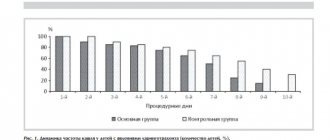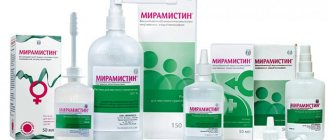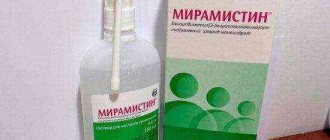Author of the article:
Soldatova Lyudmila Nikolaevna
Candidate of Medical Sciences, Professor of the Department of Clinical Dentistry of the St. Petersburg Medical and Social Institute, Chief Physician of the Alfa-Dent Dental Clinic, St. Petersburg
According to statistics, every second person on the planet has suffered from gum inflammation at least once. It is not surprising: the modern rhythm does not allow us to properly care for the oral cavity; bacteria accumulate between the teeth and begin to actively multiply, which leads to various pathologies.
One of the most popular remedies for gum inflammation is the well-known Miramistin. This powerful solution will quickly destroy harmful bacteria and return you to normal life. But how do you know when it’s time to start rinsing? How to carry out the procedure correctly? Let's figure it out together.
How to understand that inflammation has begun?
Gum inflammation is difficult to confuse with any other disease. The main symptoms of the process are:
- bleeding gums;
- sore gums;
- discomfort (pain) while eating;
- bad breath;
- inflammation after braces.
Sometimes gum inflammation is accompanied by an increase in body temperature. In such cases, you need to contact your dentist as soon as possible to identify the causes of the pathology and determine its proper treatment.
How to rinse your mouth with miramistin for gum inflammation?
To rinse, you need to put 15 ml of undiluted Miramistin in your mouth and start the procedure. When rinsing, it is important to ensure that the gums come into contact with the antiseptic. After rinsing, the drug should be spat out.
Doctors recommend repeating the procedure twice a day for 10 days until the inflammation is eliminated.
How often do dentists use Miramistin?
Miramistin is used in dental practice not only to eliminate gum inflammation. The drug in the form of a spray or solution is used to treat stomatitis, gingivitis, periodontitis, periodontitis, as well as to prevent inflammation after dental treatment or surgery.
Miramistin can also be used to treat removable dentures; the drug is excellent for the treatment of candidiasis and other fungal diseases in adults and children.
- For stomatitis,
Miramistin is suitable both in the form of a spray and in the form of a rinse solution. The spray should be used 3 times a day for 7-10 days, spraying the drug onto the mucous membrane. You can rinse your mouth with Miramistin solution. - For herpetic stomatitis,
it is worth adding antiviral and immunostimulating agents to treatment and rinsing with Miramistin, after consultation with a specialist. - In case of simple inflammation of the gums
, to increase the effectiveness of treatment, rinsing with Miramistin should be supplemented with the removal of tartar.
Does Miramistin have any contraindications?
The drug has virtually no contraindications, but Miramistin is not recommended for use for more than 10 days. Also, people with individual intolerance to the drug should not rinse their mouths with the solution. In very rare cases, Miramistin may cause an adverse reaction in the form of burning and allergies.
What else can you use?
An effective alternative to Miramistin can be Asepta Active mouth rinse. This remedy combines a combination of anti-inflammatory, analgesic components, benzydamine and the antimicrobial component chlorhexidine.
This composition complements the antiseptic effect of the mouthwash by quickly relieving pain, which significantly increases the effectiveness and speed of treatment of gum inflammation.
Miramistin, 1 piece, 150 ml, 0.01%, solution for topical use, with spray nozzle
Locally.
The drug is ready for use.
Instructions for using the packaging with spray nozzle:
1. Remove the cap from the bottle and also remove the urological applicator from the 50 ml bottle.
2. Remove the supplied spray nozzle from its protective packaging.
3. Attach the spray nozzle to the bottle.
4. Activate the spray nozzle by pressing again.
Surgery, traumatology, combustiology.
For preventive and therapeutic purposes, the surface of wounds and burns is irrigated, wounds and fistula tracts are loosely tamponed, gauze swabs soaked in the drug are fixed. The treatment procedure is repeated 2–3 times a day for 3–5 days. A highly effective method of active drainage of wounds and cavities with a daily consumption of up to 1 liter of the drug.
Obstetrics, gynecology.
In order to prevent postpartum infection, it is used in the form of vaginal irrigation before childbirth (5–7 days), during childbirth after each vaginal examination and in the postpartum period, 50 ml of the drug in the form of a tampon with an exposure of 2 hours for 5 days. When women give birth by cesarean section, the vagina is treated immediately before the operation, the uterine cavity and the incision on it are treated during the operation, and in the postoperative period, tampons soaked in the drug are inserted into the vagina with an exposure of 2 hours for 7 days. Treatment of inflammatory diseases is carried out over a course of 2 weeks by intravaginal administration of tampons with the drug, as well as by the method of medicinal electrophoresis.
Venereology.
For the prevention of sexually transmitted diseases, the drug is effective if it is used no later than 2 hours after sexual intercourse. Using a urological applicator, insert the contents of the bottle into the urethra for 2-3 minutes: for men - 2-3 ml, for women - 1-2 ml and in the vagina - 5-10 ml. Treat the skin of the inner thighs, pubis, and genitals. After the procedure, it is recommended not to urinate for 2 hours.
Urology.
In the complex treatment of urethritis and urethroprostatitis, 2-3 ml of the drug is injected into the urethra 1-2 times a day, the course is 10 days.
Otorhinolaryngology.
For purulent sinusitis, during puncture the maxillary sinus is washed with a sufficient amount of the drug.
Tonsillitis, pharyngitis and laryngitis are treated by gargling and/or irrigation using a spray nozzle, pressing 3-4 times 3-4 times a day. The amount of drug per rinse is 10–15 ml.
Children.
In case of acute pharyngitis and/or exacerbation of chronic tonsillitis, the pharynx is irrigated using a spray nozzle. At the age of 3-6 years - 3-5 ml per irrigation (press the head of the spray nozzle once) 3-4 times a day; 7–14 years — 5–7 ml per irrigation (press twice) 3–4 times a day; over 14 years old - 10-15 ml per irrigation (3-4 times pressing) 3-4 times a day. The duration of therapy ranges from 4 to 10 days, depending on the timing of remission.
Dentistry.
For stomatitis, gingivitis, and periodontitis, it is recommended to rinse the mouth with 10–15 ml of the drug 3–4 times a day.
Clinical researches
According to the results of clinical trials of the ASEPTA® rinse After 3 weeks of using the ASEPTA® rinse, gum bleeding is reduced by 28.3%, inflammation is reduced by 32.3% and the hygienic condition of the oral cavity is improved by 33.5%.
The mouthwash is designed to protect gums from inflammation and improve oral hygiene and is recommended for use by patients suffering from:
- acute and chronic gingivitis;
- acute and chronic periodontitis;
- stomatitis;
- post-extraction alveolitis;
- toothache of infectious origin.
Sources:
- The role of anti-inflammatory rinse in the treatment of periodontal diseases (L.Yu. Orekhova, A.A. Leontyev, S.B. Ulitovsky) L.Yu. OREKHOVA, Doctor of Medical Sciences, Prof., Head of Department; A.A. LEONTIEV, dentist; S.B. ULITOVSKY, Doctor of Medical Sciences, Prof. Department of Therapeutic Dentistry of St. Petersburg State Medical University named after. acad. I. P. Pavlova
- Report on clinical trials to determine/confirm the preventive properties of commercially produced personal oral hygiene products: mouth rinse "ASEPTA PARODONTAL" - Solution for irrigator." Doctor of Medical Sciences Professor, Honored Doctor of the Russian Federation, Head. Department of Preventive Dentistry S.B. Ulitovsky, doctor-researcher A.A. Leontiev First St. Petersburg State Medical University named after academician I.P. Pavlova, Department of Preventive Dentistry.
- Report on determining/confirming the preventive properties of commercially produced personal oral hygiene products: Asepta toothpaste used in combination with Asepta mouthwash and Asepta gum balm Head. Department of PFS Doctor of Medical Sciences Professor S.B. Ulitovsky St. Petersburg State Medical University named after Academician I.P. Pavlova. Faculty of Dentistry. Department of Preventive Dentistry.
Miramistin
Miramistin is an antiseptic drug for local and external use. Endowed with a wide spectrum of antibacterial action, including nosocomial microbial strains resistant to antibiotics. The drug has a pronounced bactericidal (destructive for bacteria) effect on gram-positive (Staphylococcus spp., Streptococcus spp.) and gram-negative (Escherichia coli, Klebsiella spp., Pseudomonas aeruginosa) bacteria. It has a fungicidal effect on ascomycetes of the genera Penicillium and Aspergillus, yeast (Torulopsis gabrata, Rhodotorula rubra) and yeast-like (Candida albicans, Candida krusei, Candida tropicalis, Malassezia furfur, Pityrosporum orbiculare) fungi, dermatophytes (Epidermophyton Kaufman-Wolf, Epidermophyton floccosum, Microsporum canis , Microsporum gypseum, Trichophyton mentagrophytes, Trichophyton rubrum, Trichophyton schoenleini, Trichophyton violacent, Trichophyton verrucosum) and other monocultures and associations of pathogenic fungi, including fungal microflora with resistance to chemotherapy drugs. It has antiviral activity against complex viruses (human immunodeficiency virus, herpes viruses, etc.). The drug also acts on pathogens of sexually transmitted infections (Neisseria gonorrhoeae, Chlamydia spp., Trichomonas vaginalis, Treponema spp., etc.). Effectively prevents infections of burns and open wounds. Stimulates recovery processes. Activates the occurrence of protective reactions at the site of direct use due to the activation of phagocytosis. The presence of pronounced hyperosmolar activity in Miramistin gives the drug a number of useful properties. Thus, this antiseptic is able to reduce wound and peri-wound inflammation, absorb purulent exudate, promoting the formation of a dry scab. At the same time, miramistin does not damage granulations and normal skin cells, and also does not suppress marginal epithelialization. The drug does not have irritant or allergen properties. When used topically, Miramistin is not absorbed by the skin and mucous membranes and does not enter the systemic circulation.
When used in traumatology, combustiology, surgery for therapeutic and prophylactic purposes, wound and burn surfaces are irrigated, wounds and fistula tracts are tamponed, and gauze swabs soaked in miramistin are secured. This procedure is carried out 2-3 times a day for 3-5 days. One of the most effective is the method of active drainage of wounds with a daily consumption of the drug up to 1 liter. When used in obstetric and gynecological practice, in order to prevent postpartum infection, vaginal irrigation is performed for 5-7 days before childbirth and in the postpartum period. The consumption of the drug for one such procedure is 50 ml, the exposure time is 2 hours. If the birth took place by cesarean section, then immediately before the surgical intervention the vagina is treated, during the procedure the uterine cavity is treated along with the incision made, and after the operation tampons moistened with miramistin are inserted into the vagina for 2 hours every day for 1 week. Treatment of diseases of inflammatory origin is carried out in the form of two-week courses by introducing tampons into the vagina and/or through medicinal electrophoresis. To prevent sexually transmitted diseases, Miramistin will be effective if it is used no later than 2 hours after sexual intercourse. To do this, using the included urological applicator, the contents of the bottle are introduced into the urethra for 2-3 minutes: 2-3 ml (for men), 1-2 ml and an additional 5-10 ml into the vagina (for women). The skin of the inner thighs, peripubic area and external genitalia is also treated. After this procedure, it is recommended to refrain from urinating for 2 hours. In combination therapy for urethritis, Miramistin is injected into the urethra 2-3 ml 1-2 times a day for 10 days. For inflammation of the oral mucosa and gums, as well as for periodontitis, Miramistin is used in the form of mouth rinses of 10-15 ml of solution 3-4 times a day.









